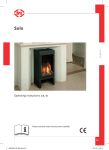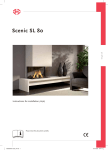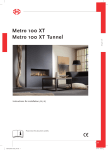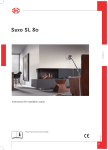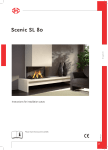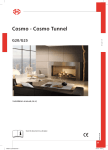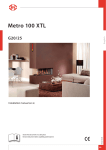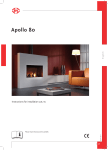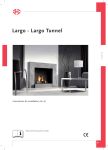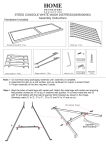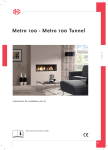Download Installation manual
Transcript
Trio English G31 Instructions for installation (GB / IE) Please retain this document carefully UK TRIO - I N S T R U C T I O N F O R I N S TA L L AT I O N Contents English Preface 1. Introduction 2. CE Declaration 3. Safety 3.1 General 3.2 Regulations 3.3 Precautions / safety instructions during installation 4. Instructions 5. Removing the packaging 6. Installation 6.1 Regulations 6.2 Type of gas 6.3 Gas connection 6.4 Placement of the appliance 6.5 Flue gas discharge / combustion air supply system 6.6 Connecting gas 6.7 Setting the appliance 6.8 Placing the wood set 6.9 Panes 7. Operation 7.1 Wireless remote control 8. Final check 8.1 Gastightness 8.2 Gas pressure / pre-pressure 8.3 Ignition pilot and main burner 8.4 Flame image 9. Maintenance 10 Delivery 11. Malfunctions Appendix 1 Parts included with the delivery Appendix 2 Technical data Appendix 3 Parts page 2 3 3 3 3 3 3 4 4 4 4 4 4 4 5 8 8 9 9 12 12 13 13 13 13 13 14 14 15 16 16 16 Preface DRU, a manufacturer of gas heating appliances, develops and produces products that comply with the highest quality, performance and safety requirements. This guarantees that the user will be able to enjoy using his product for many years to come. This appliance has a CE marking, which means that it complies with the essential requirements of the European gas appliance directive. As an installer, you must be competent in the field of atmospheric gas heating. Two manuals are supplied with the appliance: the installation manual and the user manual. The installation manual will give you the information you need to install the appliance in such a way that it will operate properly and safely. This manual discusses the installation of the appliance and the regulations that apply to the installation. In addition, you will find technical data for the appliance and information on maintenance, any malfunctions that might occur and their possible causes. Please carefully read and use this installation manual. The following symbols are used in the manual to indicate important information: ➠ Work to be performed !Tipp Suggestions and recommendations !Caution You will need these instructions to prevent problems that might occur during installation and/or use. Caution You need these instructions to prevent fire, personal injury or other serious damages. After delivery, you should give the user manual and this installation manual to the user. UK 2 TRIO 1. - I N S T R U C T I O N F O R I N S TA L L AT I O N Introduction The Trio is a freestanding atmospheric gas heating appliance. This version of the Trio is suitable for propane. The Trio is a closed appliance. A closed appliance does not extract the combustion air from the living environment, but from outside. This is done through a combined flue gas discharge system / combustion air supply system. In this concentric system the outer pipe serves as air supply and the inner pipe as flue gas discharge. This system can be installed through the wall, or through the roof. The concentric system can be supplied in the colour of the appliance. The appliance is supplied with a wireless remote control that works on batteries. 2. CE Declaration English We hereby declare that the design and construction of DRU’s atmospheric gas heating appliance comply with the essential requirements of the Gas Appliance Directive. This declaration will lose its validity if adjustments are made to the appliance, without prior written permission by DRU. Product: atmospheric gas heating appliance Type: Trio Applicable EEC directives: 90/396/EEC Applied harmonized standards: NEN-EN-613, NEN-EN-613/A1 Internal measures by the company guarantee that appliances produced in series comply with the essential requirements of the prevailing EEC directives and the standards derived from them. R. Gelten Dru verwarming B.V. Postbus 1021, 6920 BA Duiven Ratio 8, 6921 RW Duiven www.dru.nl 3. Safety 3.1 General Caution - Carefully read this chapter on safety, before you start performing installation or maintenance work; - Please observe the general regulations and the precautions/safety instructions in this manual. 3.2 Regulations Please install the appliance in accordance with the applicable national, local and constructional (installation) regulations. 3.3 Precautions / safety instructions during installation Carefully follow the following precautions/safety regulations: ➠ ➠ ➠ ➠ ➠ ➠ ➠ ➠ ➠ ➠ ➠ ➠ ➠ ➠ ➠ you should only install and maintain the appliance if you are a competent installer in the field of atmospheric gas heating; do not make any changes to the appliance; only use the flue gas discharge / combustion air supply system supplied by DRU; place the appliance at a distance of at least 40 mm from the back wall; do not cover the appliance and the discharge material and/or do not wrap it in an insulation blanket or any other material; always place the appliance and/or the discharge pipes at a minimum distance of 500 mm from combustible objects or materials; only ever use the supplied wood set; place the wood set exactly as described; make sure the pilot burner and the space around it is kept free; avoid dirt in gas pipes and connections; check the connections for gastightness before using the appliance; avoid blocking of the pressure equalization hatch on top of the appliance; check whether the pressure equalization hatch fits well onto the sealing surface; do not ignite the appliance until it is fully installed; replace torn or broken panes. 3 UK TRIO 4. - I N S T R U C T I O N F O R I N S TA L L AT I O N Instructions Observe the following items during installation in order to guarantee a proper and safe operation of the appliance: ➠ ➠ ➠ 5. avoid that the ignition cable runs over and/or alongside metal parts, in order to prevent weakening of the spark; avoid damaging the panes during removal/placing; clean the panes before you use the appliance, in order to prevent dirt from burning in the glass. Removing the packaging Note the following items when removing the packaging: ➠ ➠ ➠ Check the appliance for damages during transport; If necessary, contact DRU Service; Take the parts box and the wood set from the space behind the door at the bottom of the appliance. ➠ ➠ ➠ Remove both woodscrews from the bottom plate connecting the appliance to the platform. Contact DRU Service if you do not have all the parts after you finished removing the packaging; Dispose packaging in accordance with local regulations. English In appendix 1 / table 5 / page 17 you can see which parts you should have after removing the packaging. 6. Installation Read this manual carefully to ensure a proper and safe operation of the appliance. !Caution Install the appliance in the order described in this chapter. 6.1 Regulations - Observe the applicable (installation) regulations; - Observe the regulations/instructions in this manual. 6.2 Type of gas The type plate indicates for which type of gas, gas pressure and for which country this appliance is intended. The type plate can be found behind the door on the back wall of the space at the bottom of the appliance. ➠ Check whether the appliance is suitable for the type of gas and the gas pressure used at the location. 6.3 Gas connection Place a gas tap in the gas connection, close to the appliance. Caution Avoid dirt in the gas pipe and in the connections. The following requirements apply to the gas connection: - use a gas pipe with the correct dimensions, so that no pressure loss can occur: - the gas tap should have the CE marking; - you should always be able to reach the gas tap. 6.4 Placement of the appliance Place the appliance as follows: Caution - Always place the appliance and/or the discharge pipes at a minimum distance of 500 mm from combustible objects or materials; - Do not make any changes to the appliance. Determine the location of the appliance; the dimen➠ sions can be found in Fig. 1; Provide a gas connection at the location. For details, ➠ see section 6.3; Make a duct for the flue gas discharge/combustion ➠ air supply system with the following diameters. For details, see section 6.5. - Ø160 mm for a wall duct through incombustible material; - Ø 250 mm for a wall duct through combustible material; - Ø160 mm for a roof duct through incombustible material; - Ø 250 mm for a roof duct through combustible material. UK 4 Fig. 1 TRIO - I N S T R U C T I O N F O R I N S TA L L AT I O N Place the appliance on its destined location. ➠ Caution - Place the appliance at a distance of at least 40 mm from the back wall; - Do not cover the appliance and the discharge material and/or do not wrap it in an insulation blanket or any other material. 6.5 Flue gas discharge / combustion air supply system 6.5.1 General The appliance is of the C11/C31 type. The appliance is connected to a combined flue gas discharge/combustion air supply system, hereafter referred to as the concentric system. The passage to the outside can be made with a wall duct (see section 6.5.2) or with a roof duct (see section 6.5.3). If necessary, you can also use an existing discharge channel (see section 6.5.4). Caution - Only use the concentric system supplied by DRU (Ø100 / Ø150 mm). This system was tested in combination with the appliance; DRU cannot guarantee a proper and safe operation of other systems and cannot accept liability for these systems; - For connecting to an existing chimney flue you should only use the installation set supplied by DRU. !Tipp English The concentric system is constructed from (the discharge stump of) the appliance. If structural circumstances require that the concentric system is placed first, the appliance can later be connected with a telescopic pipe piece. DRU does not recommend placing the telescopic piece, because this visible pipe piece cannot be supplied in colour and does not really combine well with the appliance. 6.5.2 Application with wall duct 6.5.2.1 Construction of concentric system with wall duct The concentric system with wall duct has to comply with the following conditions (see Fig. 2): - First, a concentric pipe of at least 1 meter should be connected vertically to the appliance; - The total vertical pipe length can have a maximum of 4 meters; - On the vertical part a bend of 90° is connected; - Only wall ducts are allowed. Under these conditions, the baffle should be set to 60 mm (see section 6.7); the air inlet guide will not be placed. 6.5.2.2 Placing concentric system with wall duct Place the concentric system as follows: ➠ Build the system up from (the connection stump of) the appliance. Caution - Maintain a distance of at least 50 mm between the outside of the concentric system and the walls and/or the ceiling; - Use heat-resistant isolation material when passing through combustible material; - The rosette (mounting inner plate) of the wall duct is too small to seal the Ø 250 mm opening when passing through combustible material. That is why you should first apply a sufficiently large heat-resistant intermediate plate to the wall. Then, the rosette is mounted on the intermediate plate. !Caution Some heat-resistant isolation materials contain volatile components that will spread an unpleasant smell for a prolonged time; these are not suitable. Remove the top plate from the appliance; this plate is loose; ➠ Remove the cover plate by unscrewing the 2 parkers (see Photo 1); ➠ Place a lacquered pipe piece on the appliance; ➠ Apply a lacquered clip binding with silicon sealing ➠ ring onto the connection between appliance and pipe piece; Refit the cover plate with the 2 parkers; ➠ Place the top plate carefully onto the appliance, so ➠ that the lacquered pipe piece will not be damaged; If necessary, connect the vertical (lacquered) concen➠ tric pipe pieces; Connect the lacquered bend; ➠ If necessary, connect the horizontal (lacquered) con➠ centric pipe pieces; On each connection, apply a (lacquered) clip binding ➠ with silicon sealing ring; Use a parker to fix the clip binding to the pipe on lo➠ cations that are unreachable after installation; Fig. 2 5 UK TRIO - I N S T R U C T I O N F O R I N S TA L L AT I O N ➠ ➠ ➠ Apply sufficient clamps, so that the weight of the pipes does not only rest on the appliance; Determine the remaining length of the wall duct; Make sure the wall duct has the right dimensions. !Caution - Make sure that the right insertion length is maintained; - Place the wall duct with the groove/folded seam at the top; - Make sure the horizontal concentric pipe pieces are sloping towards the wall duct, in order to prevent rain water from entering. Mount the rosette (mounting inner plate); if necessary, on a heat resistant intermediate plate when passing through ➠ combustible material; Attach the wall duct from the outside with four screws in their respective holes. ➠ 6.5.3 Application with roof duct 6.5.3.1 Construction of concentric system with roof duct English The concentric system with roof duct has to comply with the following conditions: - The construction of the chosen system has to be allowed. (See the procedure described below); - First, a concentric pipe of at least 1 meter should be connected vertically to the appliance. Depending on the construction, the appliance is set by means of the baffle and/or the air inlet guide. In the following procedure you can see how the allowability of a concentric system can be determined and which settings are needed. ➠ Determine the following data: 1) The number of bends required (no distinction is made between 45° and 90° bends); 2) The total number of meters of horizontal pipe length; 3) The total number of meters of vertical and/or sloping pipe length. With these data and Table 1 you will be able to determine whether the concentric system is allowed. In Table 2 you can see which setting the appliance needs. Follow the procedure described below: ➠ ➠ In the first 2 columns of Table 1, look for the number of bends required and the total horizontal pipe length; In the 3rd column of Table 1, look for the total vertical and/or sloping pipe length. ➠ Use Table 2 to determine which conditions apply for the baffle and/or the air inlet guide (for placing/setting see section 6.7). If you end up in a box with the letter A, B, C, D or E, the concentric system chosen by you is allowed. Examples To clarify, we will give 2 examples to determine the allowability of a concentric system and the conditions for setting the appliance. In Table 1 the route to be followed is indicated by arrows. The result is outlined in red. Example 1 1) 3 bends 2) 3 meters horizontal 3) 5 meters vertical/sloping → Construction of this concentric system is allowed. → Situation D applies for setting the appliance Example 2 1) 4 bends 2) 3 meters horizontal 3) 11 meters vertical/sloping → Construction of this concentric system is not allowed. Photo 1 UK 6 TRIO - I N S T R U C T I O N F O R I N S TA L L AT I O N Table 1: Relation construction concentric system / setting appliance G31 total number of meters horizontal pipe length 1 2 3 4 앗5 6 7 8 9 10 앗11 12 no bends 0 B C C D D D D E E E E E 2 bends 0 A A B C C D D D D E E E A A B C C D D D D E A A B C C D D D A A B C C D A A B C 1 total number of meters vertical and/or sloping pipe length 2 3 4 5 0 A A B C C D D D D E 1 A A A B C C D D D D A A A B C C D D A A A B C C A A A B 2 씮 3 4 E English 3 bends 5 4 bends 0 A A A B C C D D D D 1 A A A A B C C D D D A A A A B C C D A A A A B C A A A A 2 씮 3 4 E 5 5 bends - ■ = construction is not allowed Table 2: Conditions for setting the appliance Situation Air inlet guide Baffle Distance restriction A NO YES 60 mm B NO YES 48 mm C NO YES 43 mm D NO YES 38 mm E YES YES 33 mm 6.5.3.2 Placing concentric system with roof duct The roof duct can end in a sloping and a flat roof. The roof duct can be supplied with an adhesive plate for a flat roof or with a universally adjustable tile for a sloping roof. Place the concentric system as follows: Build the system up from (the connection stump of) the appliance. ➠ Caution - Maintain a distance of at least 50 mm between the outside of the concentric system and the walls and/or the ceiling; - Use heat-resistant isolation material when passing through combustible material. !Caution Some heat-resistant isolation materials contain volatile components that will spread an unpleasant smell for a prolonged time; these are not suitable. Remove the top plate from the appliance; this plate is loose; ➠ Remove the cover plate by unscrewing the 2 parkers (see Photo 1/page 6); ➠ Place a lacquered pipe piece on the appliance; ➠ Apply a lacquered clip binding with silicon sealing ring onto the connection between appliance and pipe piece; ➠ Refit the cover plate with the 2 parkers; ➠ Place the top plate carefully onto the appliance, so that the lacquered pipe piece will not be damaged; ➠ Connect the horizontal (lacquered) concentric pipe pieces and, if necessary, the bends; ➠ On each connection, apply a (lacquered) clip binding with silicon sealing ring; ➠ Use a parker to fix the clip binding to the pipe on locations that are unreachable after installation; ➠ 7 UK TRIO - I N S T R U C T I O N F O R I N S TA L L AT I O N ➠ ➠ ➠ Apply sufficient clamps, so that the weight of the pipes does not only rest on the appliance; Determine the remaining length of the roof duct; Make sure the roof duct has the right dimensions. !Caution Make sure that the right insertion length is maintained. Connect the roof duct to the concentric pipes. ➠ !Caution - Make sure that the universal tile fits well with the surrounding tiles; - Make sure that the adhesive plate fits well onto the flat roof. 6.5.4 Connection of existing chimney flue English It is possible to connect the appliance to an existing channel. A flexible SS pipe is placed in the chimney for discharging flue gases. The surrounding space is used to supply combustion air. The following requirements apply when connecting to an existing chimney flue: - only allowed when used in combination with the special DRU chimney installation set. The installation regulation is also supplied; - the dimensions should be at least 150 x 150 mm; - the vertical length has a maximum of 12 meters; - the horizontal length has a maximum of 3 meters; - the existing chimney flue has to be clean; - the existing chimney flue has to be closed. 6.6 Connecting gas Use the following procedure when connecting the gas, see section 6.3 Gas connection: ➠ ➠ If necessary, blow through the gas pipe. Connect the gas pipe with gas tap to the gas control block. !Caution - You can find the gas control block behind the door in the space at the bottom of the appliance; - Do not turn the gas tap when connecting the gas pipe. Bleed the gas pipe. ➠ 6.7 Setting the appliance The appliance has to be set in such a way that is works correctly in combination with the discharge system. For that purpose it is possible to install a baffle and/or an air inlet guide. For the conditions, see section 6.5.2.1, for application with wall duct and section 6.5.3.1, Table 2, for application with roof duct. 6.7.1 Baffle (R) The baffle (R) is supplied separately. Follow the procedure below when placing the baffle: ➠ ➠ ➠ Remove the front pane as indicated in section 6.9.1. Place the baffle (see Fig. 3). Use the template supplied to set the distance of the restriction (see Fig. 4) as follows: - A distance of 33 mm means that the baffle is closed to a maximum level; - A distance of 38, 43.48 and 60 mm is set by using a template. ➠ Fix the baffle by using the socket cap screw (S). 38 43 48 60 38c-1220 Fig. 3 UK 8 Fig. 4 Photo 2 TRIO - I N S T R U C T I O N F O R I N S TA L L AT I O N 6.8 Placing the wood set The appliance is supplied with a wood set. Caution Strictly observe the following instructions to prevent unsafe situations: - only ever use the supplied wood set; - place the wood set exactly as described; - make sure the pilot burner and the space around it are kept free from objects (see Photo 2); - make sure that the slot between the burner tray and the tray surrounding the burner is kept free from objects. 6.8.1 Wood set ➠ The wood set consists of vermiculite (see Photo 3), chips (see Photo 4) and a number of blocks. Fill the burner tray with vermiculite; equally spread the vermiculite (see Photo 8). English !Caution - You can influence the flame image by moving the vermiculite, yet - the burner deck has to remain covered with vermiculite in order to prevent that the life expectancy of the burner is reduced Fill the tray around the burner with chips; equally spread the chips. ➠ Identify blocks A up to F by using Photo 5. ➠ !Tipp Use the burn stains on the blocks for identification. First place blocks A and B (see Photo 6). ➠ Caution - Place block A in such a way that the pilot flame and flame opening are not covered. Photo 6 shows how it should be done, and Photo 6a shows how it should not be done Then place blocks C up to F (see Photo 7). ➠ 6.9 Panes 6.9.1 Front pane After placing the wood set you can place the front pane as described below. !Caution - Avoid/remove fingerprints on the pane, as they will burn into the glass. Photo 3 Photo 4 Photo 5 9 UK English TRIO U K 10 Photo 6 Photo 6a Photo 7 Photo 8 - I N S T R U C T I O N F O R I N S TA L L AT I O N - I N S T R U C T I O N F O R I N S TA L L AT I O N English TRIO Photo 9 Photo 10 Photo 11 Photo 12 6.9.1.1 Removing the front pane When removing the front pane, you should observe the instructions below; see Photo 9 to 12: ➠ ➠ ➠ ➠ ➠ ➠ Open the door; Unscrew the 6 parkers of the glass strip at the sides by using the socket spanner supplied; Remove the glass strips; Unscrew the 3 parkers of the upper glass strip; Hold the pane and remove the upper glass strip; Remove the pane from the slot at the underside. 6.9.1.2 Placing the front pane Placing the front pane will take place in reverse order of the removal procedure described above. !Caution Do not screw the parkers on too tight, to prevent breaking and/or slipping: tight=tight. 11 UK TRIO - I N S T R U C T I O N F O R I N S TA L L AT I O N 6.9.2 Side panes The side panes should be removed in case of torn or broken panes. 6.9.2.1 Removing the side pane Follow the steps below for removing: ➠ ➠ ➠ ➠ ➠ ➠ Carefully remove the top plate from the appliance, so that the lacquered pipe piece will not be damaged. The top plate is loose; Slide the housing upwards at the side (see Photo 13); Remove this part of the housing; Unscrew the 3 parkers at the top by using the socket spanner; Hold the pane and remove the glass strip; Remove the pane from the slot at the underside. 6.9.2.2 Placing the side pane English Placing the side pane will take place in reverse order of the removal procedure described above. !Caution Do not screw the parkers on too tight, to prevent breaking and/or slipping: tight=tight. Photo 13 7. Operation See the User Manual, chapter 4, Operation, for the operation of the appliance. 7.1 Wireless remote control The wireless remote control consists of a remote control and a receiver. Below you can read how you should connect the receiver; the operation of the wireless remote control will be discussed in the User Manual, chapter 4, Operation. 7.1.1 Connecting the receiver ➠ The receiver is placed behind the door in the space at the bottom of the appliance. The gas control block is also placed in this space. The receiver should be connected to the appliance, before the batteries are installed. Follow the procedure below: Connect the connecting cable of the receiver to the gas control block (see Photo 14 + 15). !Tipp The plugs have different sizes that correspond with the connectors. Place the batteries as described below in section 7.1.2; Place the receiver in its holder, with the sensor to the front, see Photo 15. !Caution Do not place the ignition cable over and/or along metal parts: this will weaken the spark. ➠ ➠ 7.1.2 Placing / replacing the batteries Follow the procedure below when placing / replacing the batteries: ➠ ➠ ➠ ➠ Open the door; Pick up the receiver; Slide the cover off; Place or remove the 4 penlite (AA type) batteries. !Caution - Avoid a short circuit between the batteries and metal objects/parts; - Observe the “+” and “-” poles of the batteries and the holder; - Use alkaline batteries. Slide back the cover; ➠ Place the receiver in the holder with the sensor to the ➠ front. !Caution Batteries are regarded as “small chemical waste” and may therefore not be disposed with the household rubbish. Photo 14 U K 12 TRIO 8. - I N S T R U C T I O N F O R I N S TA L L AT I O N Final check In order to check whether the appliance is working properly and safely, you must perform the following checks before the appliance is used. 8.1 Gastightness Caution All connections must be gastight. !Caution The gas control block can be subjected to a maximum pressure of 50 mbar. Check the connections for gastightness. ➠ 8.2 Gas pressure / pre-pressure English ➠ ➠ The burner pressure is set at the factory; see type plate. It is not necessary to check the burner pressure. The pre-pressure in house installations, however, Photo 15 should be checked, as they can vary. Check the pre-pressure; see Photo 16 for the measuring nipple on the gas control block; Contact the gas company if the pre-pressure is not correct. 8.3 Ignition pilot and main burner For igniting the pilot and main burner, see the User Manual, chapter 4, Operation. Caution Always wait 5 minutes after the pilot flame has gone out, before you re-ignite the appliance. 8.3.1 Pilot flame ➠ Check the ignition of the pilot flame. - the pilot flame burner should start at the first attempt. If the pilot flame does not burn: ➠ ➠ ➠ Check if the ignition sparks: a) If not, the ignition cable is probably not lying free from metal parts; b) If it does, there is probably still air in the pipe. Bleed the pipe and/or; Lay the ignition cable free from metal parts. 8.3.2 Main burner The main burner is ignited with button B on the gas control block. Button B can be operated by the remote control and by hand, see the User Manual, chapter 4, Operation. Caution The burner should ignite smoothly and should not pop as a result of postponed ignition. Check the function of the main burner from the pilot flame position: ➠ - after opening the gas valve, the main burner should burn within a few seconds. If the main burner does not burn: ➠ ➠ ➠ ➠ ➠ Check if button A on the gas control block is in the position Check if the space surrounding the pilot flame is free from objects; Check the placement of the wood set; If necessary, correct the abovementioned failures; Test the main burner 5x for a good operation. ; 8.4 Flame image The flame image can only really be assessed when the appliance has been burning for several hours. Volatile components from paint, materials, etc., which evaporate in the first hours, will affect the flame image. ➠ Check the flame image. If the flame image is not acceptable, this can be due to: - the evaporation of volatile substances; - incorrect placement of the wood set. ➠ If necessary, improve the placement of the wood set. Photo 16 13 U K TRIO 9. - I N S T R U C T I O N F O R I N S TA L L AT I O N Maintenance Once a year the appliance should be checked, cleaned and, if necessary, repaired by a competent installer in the field of atmospheric gas heating. Check at least whether the appliance is working properly and safely. English Caution - Close the gas tap when performing maintenance work; - Check the gastightness after repair; - After replacing the thermocouple you should first tighten the swivel of the gas control block by hand and then give it another quarter turn with a suitable spanner. If required, clean the following components: ➠ - the pilot flame burner; - the combustion room; - the panes. !Caution - Remove/place the front pane as described in section 6.9.1; - Remove the deposit on the inside of the pane with a damp cloth or a non-abrasive detergent such as copper polish; - Avoid/remove fingerprints on the pane, as they will burn into the glass; - Replace a torn or broken pane as described in section 6.9. Caution - If necessary, place back the wood set correctly; see section 6.8. Inspect the flue gas discharge / combustion air supply system; ➠ Perform a check as described in chapter 8. ➠ 10 Delivery You must explain to the user how he should operate the appliance. You should instruct her/him for instance on using the appliance for the first time, the operation of the remote control, annual maintenance. Caution - Tell the user to close the gas tap immediately in case of malfunctions/bad performance and contact the installer in order to prevent dangerous situations; - Indicate the location of the gas tap. Instruct the user about the appliance and the remote control; ➠ When the appliance is started for the first time, point out that: ➠ - when the appliance is stoked up for the first time, volatile components evaporate from paint, materials, etc.; - when evaporating the appliance should preferably be set at the highest level; - the room should be well ventilated. Give the user manual and installation manual to the user (the installation manual should be kept near the appliance). ➠ U K 14 11. - I N S T R U C T I O N F O R I N S TA L L AT I O N Malfunctions In the following table you will find an overview of malfunctions that might occur, the possible causes and the remedies Table 4: Troubleshooting Problem Possible cause A. No transmission (mo- 1. Empty batteries. tor will not run) B. No ignition (spark) C. No pilot flame Remedy 1. Replace batteries. !Caution Avoid short circuit between the batteries and metal parts of the appliances. 2. Receiver is damaged. 2. Replace the receiver. 3. Remote control is damaged. 3. Replace the remote control. 4. Motor cable at gas control block is broken. 4. Replace the motor cable. 1. Ignition cable runs over and/or 1. Do not place the ignition cable over and/or alongside metal parts. along metal parts. This will weaken the spark. If necessary, replace the ignition cable. 2. Ignition pen corroded. 2. Replace the ignition pen. 1. Air in the pilot flame pipe. 1. Flush the pipe or start the ignition process several times. 2. No spark at the pilot flame burner. 2. Check if the ignition cable is lying free from metal parts. If necessary, move it away from the metal parts; - If necessary, replace the ignition cable - If necessary, replace the ignition pen 3. Injector is blocked up 3.1 Clean the injector 3.2 If necessary, replace the injector English TRIO D. Pilot flame is burning, 1. Button A on the gas control 1. Turn button A to the position see Photo 14 but there is no gas flow block is in position . to the main burner 2. Button B on the gas control 2. Increase flame height by turning button B block is on pilot flame position counter-clockwise or by pressing on button ▲ ● (see Photo 14). of the remote control. 3. Pre-pressure of the gas is too low. 3. Check the pre-pressure. If necessary, activate energy mode. 4. Damaged magnet valve. 4. Replace the gas control block. 15 U K TRIO - I N S T R U C T I O N F O R I N S TA L L AT I O N Appendix 1 Parts included with the delivery In the following table you can find the parts that are supplied with the appliance. Table 5: Parts included with the delivery Part Quantity Order number Wood set 1x 806560 Installation manual 1x 95900401 User manual 1x 95800200 Setting template for baffle 1x 38714251 Baffle 1x 38741363 Socket spanner 1x 790811 Remote control with receiver 1x 806014 9V block battery 1x 923001 Penlite battery (AA type) 4x 923100 Squeeze coupling 15 mm x G3/8” 1x 149234 English Spare parkers for mounting the front pane Appendix 2 Technical data In the following table you can find the technical data. Table 6: Technical data Type C11/C31 Type of gas Burner pressure mbar 30 Nom. load (Hs) kW 5.8 Nom. load (Hi) kW 5.2 Nom. output kW 4.0 Consumption L/h 213 mm front Ø 0,90 rear Ø 0,90 Consumption on low output L/h 142 Low setting injector mm Ø 1.20 Pilot flame injector code 30 Burner injector Efficiency class Appendix 3 Parts Parts can be ordered through www.druservice.nl U K 16 G31 2 TRIO - I N S T R U C T I O N F O R I N S TA L L AT I O N Notes .................................................................................................................................................................................................................... .................................................................................................................................................................................................................... .................................................................................................................................................................................................................... .................................................................................................................................................................................................................... .................................................................................................................................................................................................................... .................................................................................................................................................................................................................... .................................................................................................................................................................................................................... .................................................................................................................................................................................................................... .................................................................................................................................................................................................................... .................................................................................................................................................................................................................... English .................................................................................................................................................................................................................... .................................................................................................................................................................................................................... .................................................................................................................................................................................................................... .................................................................................................................................................................................................................... .................................................................................................................................................................................................................... .................................................................................................................................................................................................................... .................................................................................................................................................................................................................... .................................................................................................................................................................................................................... .................................................................................................................................................................................................................... .................................................................................................................................................................................................................... .................................................................................................................................................................................................................... .................................................................................................................................................................................................................... .................................................................................................................................................................................................................... .................................................................................................................................................................................................................... .................................................................................................................................................................................................................... .................................................................................................................................................................................................................... .................................................................................................................................................................................................................... .................................................................................................................................................................................................................... .................................................................................................................................................................................................................... .................................................................................................................................................................................................................... .................................................................................................................................................................................................................... .................................................................................................................................................................................................................... .................................................................................................................................................................................................................... .................................................................................................................................................................................................................... .................................................................................................................................................................................................................... .................................................................................................................................................................................................................... .................................................................................................................................................................................................................... .................................................................................................................................................................................................................... .................................................................................................................................................................................................................... 17 U K TRIO Notes .................................................................................................................................................................................................................... .................................................................................................................................................................................................................... .................................................................................................................................................................................................................... .................................................................................................................................................................................................................... .................................................................................................................................................................................................................... .................................................................................................................................................................................................................... .................................................................................................................................................................................................................... .................................................................................................................................................................................................................... .................................................................................................................................................................................................................... .................................................................................................................................................................................................................... .................................................................................................................................................................................................................... .................................................................................................................................................................................................................... .................................................................................................................................................................................................................... .................................................................................................................................................................................................................... .................................................................................................................................................................................................................... .................................................................................................................................................................................................................... .................................................................................................................................................................................................................... .................................................................................................................................................................................................................... .................................................................................................................................................................................................................... .................................................................................................................................................................................................................... .................................................................................................................................................................................................................... .................................................................................................................................................................................................................... .................................................................................................................................................................................................................... .................................................................................................................................................................................................................... .................................................................................................................................................................................................................... .................................................................................................................................................................................................................... .................................................................................................................................................................................................................... .................................................................................................................................................................................................................... .................................................................................................................................................................................................................... .................................................................................................................................................................................................................... .................................................................................................................................................................................................................... .................................................................................................................................................................................................................... .................................................................................................................................................................................................................... .................................................................................................................................................................................................................... .................................................................................................................................................................................................................... .................................................................................................................................................................................................................... .................................................................................................................................................................................................................... .................................................................................................................................................................................................................... .................................................................................................................................................................................................................... 18 TRIO Notes .................................................................................................................................................................................................................... .................................................................................................................................................................................................................... .................................................................................................................................................................................................................... .................................................................................................................................................................................................................... .................................................................................................................................................................................................................... .................................................................................................................................................................................................................... .................................................................................................................................................................................................................... .................................................................................................................................................................................................................... .................................................................................................................................................................................................................... .................................................................................................................................................................................................................... .................................................................................................................................................................................................................... .................................................................................................................................................................................................................... .................................................................................................................................................................................................................... .................................................................................................................................................................................................................... .................................................................................................................................................................................................................... .................................................................................................................................................................................................................... .................................................................................................................................................................................................................... .................................................................................................................................................................................................................... .................................................................................................................................................................................................................... .................................................................................................................................................................................................................... .................................................................................................................................................................................................................... .................................................................................................................................................................................................................... .................................................................................................................................................................................................................... .................................................................................................................................................................................................................... .................................................................................................................................................................................................................... .................................................................................................................................................................................................................... .................................................................................................................................................................................................................... .................................................................................................................................................................................................................... .................................................................................................................................................................................................................... .................................................................................................................................................................................................................... .................................................................................................................................................................................................................... .................................................................................................................................................................................................................... .................................................................................................................................................................................................................... .................................................................................................................................................................................................................... .................................................................................................................................................................................................................... .................................................................................................................................................................................................................... .................................................................................................................................................................................................................... .................................................................................................................................................................................................................... .................................................................................................................................................................................................................... 19 959.004.01.UK DRU Verwarming B.V. The Netherlands Postbus 1021, NL-6920 BA Duiven Ratio 8, NL-6921 RW Duiven





















